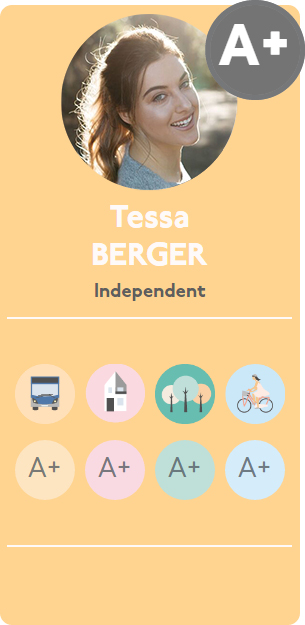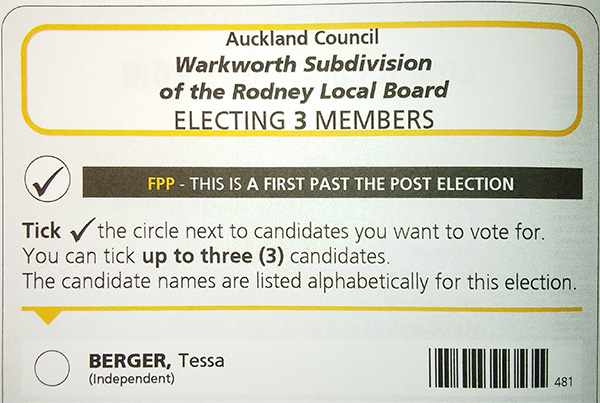Only council candidate to score straight-a pluses


Tessa Berger Straight-a+ Candidate: Although Councillor Penny Webster rated well in Generation Zero’s Auckland election scorecards, her overall B+ has just been put to shame by Tessa Berger’s straight-a-pluses. No other Rodney Local Board candidates bothered to engage in the region-wide Generation Zero survey, in which even Chlöe Swarbrick only received an A-minus. image Generation Zero
Warkworth from 4000 to 20 000 by 2040. That would be a five-fold increase in less than half the 50 years it took the region to treble to today’s population, of about 1.5 million.
With this planned growth-rate of more than three times the regional average, Warkworth is essentially going to become a new town. While the Auckland Council had assumed that Warkworth’s growth spurt wouldn’t kick in until post the motorway completion, urban growth there is manifesting its inconvenient tendency to get ahead of its planners. This means that the three fundamental questions about how the town will develop have now become urgent:
- Will the character of the existing town survive?
- What will the character of the new town be?
- To what extent will the new and old be complementary, and connected?
The truly urgent need is for the Warkworth community to help shape how the new town is to develop, or leave it to the developers and one-size-fits-all Auckland Unitary Plan rules.
Structure plans are the mechanism that potentially allows communities to shape their development. Such plans, as passionate Warkworth-based planner Burnette Macnicol explained to the town’s business community on Wednesday evening, can be highly detailed or broad-brushstroke. The trap with becoming too detailed, she said, is that a structure plan can take forever to be agreed upon. And time is not on the side of those who have hopes that the new town can be other than same-old-same-old, car-centric and unwalkable.
A structure plan, by itself, is merely a guiding document and has no teeth. To give it teeth, however, a variation to the Auckland Unitary Plan will have to be made to change the rules and zonings of the land already designated for Warkworth’s growth. Developers will then have the choice of meeting those new requirements, and readily receiving planning approval, or bucking them and taking their chances with non-complying applications. The more strongly the Warkworth community engages in the structure plan process, the less wriggle room developers will be left with for projects that disrespect the town’s collective vision for its future.
At Burnette Macnicol’s urging, Auckland Council is hastening commencement of the structure plan process, which wasn’t due to get underway until 2018. Burnette has also urged that the opportunity be taken with an existing Rodney Local Board funded project, aimed at eliciting priorities for Warkworth projects, to also seek the community’s vision for its new town, quadruple the size of the existing one. Part of the project involves a stall at the Kōwhai Festival, on Sunday 9 October, focussing on aspirations for the essence of Warkworth, the Mahurangi River, between Hills Street and the Wilson Cement Works. Thanks to Burnette, this will now also elicit aspirations for the new Warkworth.

Dick of a System Dictates First-Past-the-Post: Voters have every right to feel short-changed for not being able to vote for more than one candidate, when, in the case of the Warkworth subdivision, they are entitled to express their preferences for at least three. For Tessa Berger supporters, voting with more than one tick could cost her a place on the Rodney Local Board. image Auckland Council
Meantime, there’s an election underway—arguably the most important one ever for the future of Warkworth. One candidate, of course, has made her campaign about the future of northeastern Rodney from the get-go, with her fresh, all-to-appealing billboards extolling residents to ‘Vote for the future.’ Small wonder then that Tessa Berger has just aced Generation Zero’s Auckland election scorecards:
This straight-a-plus result is entirely typical of the Mahurangi born-and-bred 22-year-old who, as a student of Florida Gulf Coast University, achieved American President’s List scholar. Meanwhile, whether voters will score an A+ for understanding that, if they strongly support a particular candidate—thanks to first-past-the-post—they should vote for one not three local board members, won’t be known until Saturday week.
BERGER, Tessa for local board member
